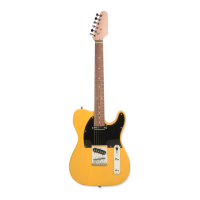
Do you have a question about the StewMac T-STYLE and is the answer not in the manual?
| Brand | StewMac |
|---|---|
| Model | T-STYLE |
| Category | Musical Instrument |
| Language | English |
Sketch your peghead design on heavy paper and trace it onto the neck using a pencil with a light touch.
Cut the peghead shape using a bandsaw or jigsaw, ensuring the saw stays square to the peghead face.
Fill the mahogany body's open grain with grain filler for a flat surface before applying finish.
Sand the body with progressively finer grits (150, 220, 320) to prepare for finishing.
Sand the neck with 220 and 320-grit sandpaper, avoiding fret tops and softening sharp edges.
Wipe the body and neck with a naphtha-dampened rag to remove oils and grease before finishing.
Follow a three-day schedule for applying ColorTone aerosol lacquers for body and neck finishing.
Adjust the truss rod with a straightedge to ensure fret tops are aligned without rocking.
Use sandpaper on a radius block to level fret tops, ensuring they are smooth and even.
Sand frets with 400 and 600-grit paper, then polish with Scotch-Brite or steel wool for a smooth finish.
Mount tuners on the peghead, ensuring alignment, and secure with screws and bushings.
Attach the bridge to the body, ensuring the pickup wire runs through the cavity to the control cavity.
Mount the neck pickup through the pickguard, feeding its wire to the control cavity.
Drill neck mounting holes square to the neck, 11/16" deep, using a 1/8" bit.
Position and attach the pickguard and control plate, marking and drilling mounting holes.
Solder the two-strand hookup wire from the volume pot to the output jack's tip and sleeve lugs.
Install string retainers on the peghead to maintain proper string angle over the nut.
Adjust neck relief to allow string vibration and prevent fret buzz, aiming for a slight upbow.
Lower string nut slots using gauged files to set comfortable string height over the 1st fret.
Adjust bridge saddles to set string height over the 12th fret for optimal playability.
